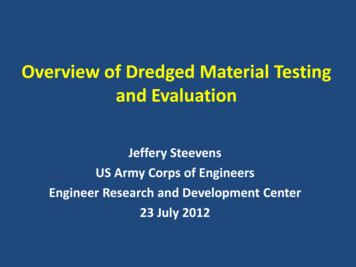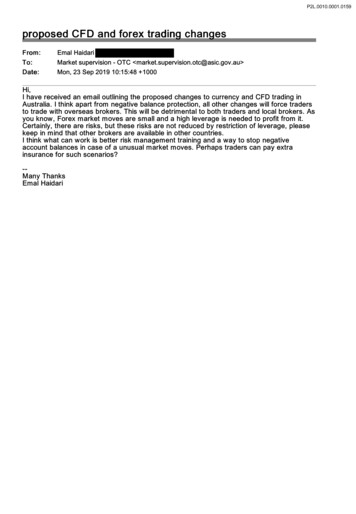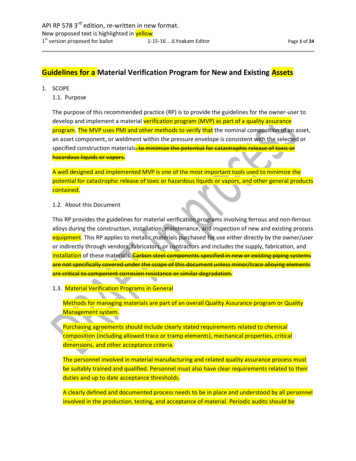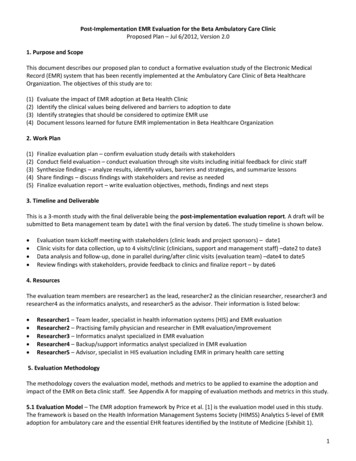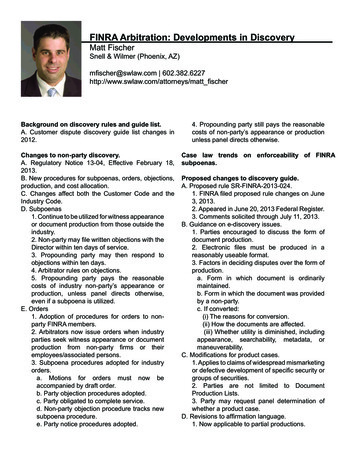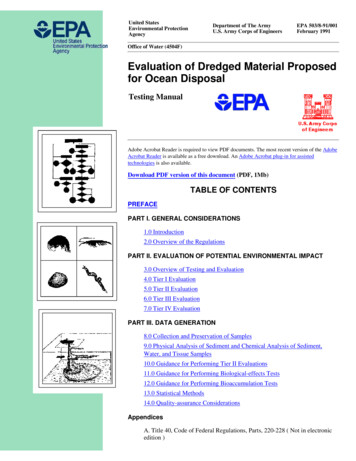
Transcription
United StatesEnvironmental ProtectionAgency&EPAUnited SlatesEnwlron1men1tal Protect· nA9encyDepartment of The ArmyU.S. Army Corps of EngineersEPA 503/8-91/001February 1991Office of Water (4504F)Evaluation of Dredged Material Proposedfor Ocean DisposalTesting Manual&EPAU.S. Anny Co rpsof Engineera --::-11.I}.Adobe Acrobat Reader is required to view PDF documents. The most recent version of the AdobeAcrobat Reader is available as a free download. An Adobe Acrobat plug-in for assistedtechnologies is also available.Download PDF version of this document (PDF, 1Mb)TABLE OF CONTENTS''PREFACEPART I. GENERAL CONSIDERATIONS1.0 Introduction2.0 Overview of the RegulationsPART II. EVALUATION OF POTENTIAL ENVIRONMENTAL IMPACT3.0 Overview of Testing and Evaluation4.0 Tier I Evaluation5.0 Tier II Evaluation6.0 Tier III Evaluation7.0 Tier IV EvaluationPART III. DATA GENERATION8.0 Collection and Preservation of Samples9.0 Physical Analysis of Sediment and Chemical Analysis of Sediment,Water, and Tissue Samples10.0 Guidance for Performing Tier II Evaluations11.0 Guidance for Performing Biological-effects Tests12.0 Guidance for Performing Bioaccumulation Tests13.0 Statistical Methods14.0 Quality-assurance ConsiderationsAppendicesA. Title 40, Code of Federal Regulations, Parts, 220-228 ( Not in electronicedition )
B. Numerical Models for Initial-mixing EvaluationsPREFACECLAMSHl:U. DFiEDGEAccording to Section 103 of Public Law 92-532 (the Marine Protection, Research,and Sanctuaries Act of 1972), any proposed dumping of dredged material into oceanwaters must be evaluated through the use of criteria published by the EnvironmentalProtection Agency (EPA) in Title 40 of the Code of Federal Regulations, Parts220-228 (40 CFR 220-228). This testing guidance manual contains proceduresapplicable to the evaluation of potential contaminant-related environmental impactof the ocean disposal of dredged material. It will be periodically revised and updatedas warranted by advances in regulatory practice and technical understanding. Thismanual was approved by EPA and the United States Army Corps of Engineers(USACE) in 1991 and it replaces the July 1977 manual, Ecological Evaluation ofProposed Discharge of Dredged Material into Ocean Waters, which is no longerapplicable.Review of this manual was conducted by EPA through the Marine OperationsDivision of the Office of Marine and Estuarine Protection and by the USACEthrough the Office of the Chief of Engineers and the Environmental Laboratory ofthe Waterways Experiment Station. Significant input on regional issues that haveNational relevance was received from EPA Region and USACE District staff andincorporated into the appropriate sections of this document.
US Environmental Protection AgencyEvaluation of Dredged Material Proposed for Ocean DisposalTesting ManualPart I: General Considerations1.0 INTRODUCTIONThis manual, commonly referred to as the "Green Book," is an update of EcologicalEvaluation of Proposed Discharge of Dredged Material into Ocean Waters(EPA/USACE, 1977). The manual contains technical guidance for determining thesuitability of dredged material for ocean disposal through chemical, physical, andbiological evaluations. The technical guidance is intended for use by dredging applicants,laboratory scientists, and regulators in evaluating dredged-material compliance with theUnited States Ocean Dumping Regulations.Integral to the manual is a tiered-testing procedure for evaluating compliance with thelimiting permissible concentration (LPC) as defined by the ocean-dumping regulations.The procedure comprises four levels (tiers) of increasing investigative intensity thatgenerate information to assist in making ocean-disposal decisions. Tiers I and II utilizeexisting or easily acquired information and apply relatively inexpensive and rapid tests topredict environmental effects. Tiers III and IV contain biological evaluations that aremore intensive and require field sampling, laboratory testing, and rigorous data analysis.This manual provides National technical guidance for use in making LPC compliancedeterminations for proposed discharges of dredged material; it does not providecomprehensive guidance on other factors that should be considered during thesediment-evaluation process. Decision-making, involving the evaluation of regulationsand local policies, site conditions, and project-specific management actions to limitenvironmental impacts, is addressed in other Environmental Protection Agency(EPA)/United States Army Corps of Engineers (USACE) guidance manuals.1.1 BACKGROUNDSection 103 of the Marine Protection, Research, and Sanctuaries Act of 1972 (MPRSA),Public Law 92-532, specifies that all proposed operations involving the transportationand dumping of dredged material into ocean waters have to be evaluated to determine thepotential environmental impact of such activities. This is performed by the Secretary ofthe Army, using criteria developed by the Administrator of the EPA. In accordance withSection 103 of the MPRSA, the USACE is the permitting authority for dredged material,subject to EPA review. Environmental evaluations have to be in accordance withapplicable criteria published in Title 40, Code of Federal Regulations, Parts 220-228 (40CFR 220-228), hereafter referred to as the regulations. Proposed ocean disposal ofdredged material also has to comply with the permitting and dredging regulations given
in Title 33 CFR, Parts 320-330 and 335-338.Appendix A of this manual contains a reprinting of 40 CFR Parts 220-228. However, thismanual addresses only the technical requirements that apply to contaminant evaluation(see. 227.6 and 227.13).One of the main purposes of Section 103 of the MPRSA is to regulate and limit adverseecological effects of ocean dumping of dredged material. Consequently, the regulationsemphasize evaluative techniques such as bioassays and bioaccumulation testing, whichprovide relatively direct estimates of the potential for environmental impact.1.2 APPLICABILITYThis manual is applicable to all activities involving the transportation of dredged materialfor the purpose of dumping it in ocean waters outside the baseline from which theterritorial sea is measured. The guidance in this manual is applicable to dredgingoperations conducted under permits as well as to Federal projects conducted by theUSACE. In this manual, terms such as dredging project, etc., are used in the broadestsense to include Federal projects as well as operations conducted under permits. Theprocedures in this manual do not apply to activities excluded by . 220.1 of theregulations.Although it is important to remember that the regulations are legally binding and that theguidance provided in this manual is necessarily responsive to the specific requirements ofthese regulations, the manual is not intended to carry the force of law. This documentdoes, however, contain jointly acceptable technological approaches for evaluating thepotential environmental impact of the ocean disposal of dredged material as agreed uponby EPA and the USACE.1.3 PURPOSE AND SCOPEThis manual was developed under the direction of a joint EPA/USACE work group andprovides a balance between technical state-of-the-art and routinely implementableguidance for using the evaluative procedures specified in the regulations. Guidance isincluded on the appropriate uses and limitations of the various procedures and on soundinterpretation of the results.This manual contains summaries and discussions of the procedures for ecologicalevaluation of dredged material required by the regulations, tests to implement them,definitions, sample-collection and preservation procedures, evaluative procedures,calculations, interpretive guidance, and supporting references required for the evaluationof dredged-material discharge applications in accordance with the regulations. Even so,
this manual cannot stand alone. It is imperative that the supporting references beconsulted for detailed or more comprehensive guidance whenever indicated. Before anyevaluations are begun, THIS MANUAL AND ESPECIALLY THE REGULATIONS IN 40CFR 220-228 SHOULD BE READ IN THEIR ENTIRETY, and citations and referencesshould be consulted to obtain an understanding of the guidance that the manual provides.The technical procedures in this manual are designed only for dredged material andshould not be used for any other materials unless definitive research demonstrates theirapplicability.This manual contains evaluative procedures considered to be acceptable tools forregulation. As warranted through experience with this manual and the development ofnew procedures, sections of this manual will be updated periodically and the availabilityof these updates will be announced. Because this manual is National in scope, it cannotaddress every local concern, and cannot provide detailed guidance appropriate to everysuch issue. Therefore, development of more detailed implementation guidance tailoringthe procedures of this manual to local needs is encouraged. It is essential to the ecologicalevaluation approach in the manual that detailed technical agreements on the approachesto be used for all disposal applications be developed jointly and cooperatively by the EPARegional Administrator and the USACE DIstrict Engineer, by considering the input ofinvolved local parties and the appropriate scientists in both agencies. Local guidance hasto comply with all applicable regulations, and should be compatible with the guidance inthis manual. If there is disagreement between an EPA Region and a USACE District,disputes should be resolved jointly by the headquarters of EPA and the USACE.This manual does not address management actions that could be used to reduce impactassociated with dredged-material disposal. Management actions for dredged material caninclude control of dump releases, disposal-site capping, submarine burial, and predisposaltreatment. However, these actions are both project- and region-specific and are beyondthe scope of the National guidance provided by this manual. The decision as to whethersuch material might be allowable for ocean disposal under the MPRSA and otherapplicable regulations, and the procedural steps to be followed in making thisdetermination, are issues that are beyond the scope of this manual.1.4 ORGANIZATION OF THIS MANUALThis manual is organized into three parts and two appendices. Part I, GeneralConsiderations, presents the purpose and background of the manual and summarizes theFederal regulations that are relevant to dredged-material evaluation. Part II, Evaluation ofPotential Environmental Impact, presents guidance on the testing and evaluation ofdredged material that is proposed for ocean disposal. Sections 4.0 through 7.0 of Part IIdescribe the components of the four tiers in the tiered-testing procedure. Part III, DataGeneration, presents guidance on sampling, physical and chemical analysis,biological-effects evaluation, statistical methods, and quality assurance. Appendix A is areprint of the ocean-dumping regulations (40 CFR 220-228) and Appendix B provides
technical guidance for using the numerical models to calculate initial mixing.1.5 CHANGES FROM AND REVISIONS TO THE PREVIOUSMANUALThis manual replaces the document Ecological Evaluation of Proposed Discharges ofDredged Material into Ocean Waters, published by EPA/USACE in 1977 (reprinted in1978). This revised manual provides implementation guidance compatible with the 1977Ocean Dumping Regulations (40 CFR 220-228) and reflects experience gained since1977 with environmental regulation of the ocean disposal of dredged material. Althoughmany changes have been made in the format and content of the manual, the generalapproach of providing the technical rationale of the regulations, test procedures, andinterpretive guidance is the same, and this manual is consistent with the provisions of theexisting regulations. The test endpoints and evaluative guidance have been refined, butthe basic concepts are similar to those of the preceding manual.The manual has been structured for better presentation of the expanded availableinformation on environmental evaluation of dredged material. Part I is similar in contentto Parts I and II of the 1977 manual, but with the addition of a Section that discusses theconcepts of tiered testing and appropriate reference and control materials. Part IIaddresses how to evaluate potential environmental impact at each tier of evaluation, andprovides guidance on how to use the results at each tier to make decisions. Part III isanalogous to the appendices of the 1977 manual. It gives field and laboratory guidancefor gathering data and discusses quality assurance/quality control considerations.1.6 DEFINITIONSThe following terms are briefly defined and interpreted for purposes of this document.See Subpart G of the regulations for complete definitions of terms used in the regulations.Acute toxicityLevel of mortality by a group of marine organisms that have been affectedby the properties of a substance, such as a contaminated sediment. The acutetoxicity of a sediment is determined by quantifying the mortality ofappropriately sensitive organisms that are put into contact with the sediment,under either field or laboratory conditions, for a specified period.BioaccumulationThe accumulation of contaminants in the tissues of organisms through anyroute, including respiration, ingestion, or direct contact with contaminatedsediment or water. The regulations require that bioaccumulation be
considered as part of the environmental evaluation of dredged materialproposed for ocean dumping. This consideration involves predicting whetherthere will be a cause-and-effect relationship between an animal's presence inthe area influenced by the dredged material and an environmentallyimportant elevation of its tissue content or body burden of contaminantsabove that in similar animals not influenced by the disposal of the dredgedmaterial.ConstituentsChemical substances, solids, organic matter, and organisms associated withor contained in or on dredged material.Control sedimentA natural sediment essentially free of contaminants and compatible with thebiological needs of the test organisms such that it has no discernableinfluence on the response being measured in the test. Test procedures areconducted with the control sediment in the same way as the referencesediment and dredged material. The purpose of the control sediment is toconfirm the biological acceptability of the test conditions and to help toverify the health of the organisms during the test. Excessive mortality in thecontrol sediment indicates a problem with the test conditions or organisms,and can invalidate the results of the corresponding dredged material test.Disposal siteA precise geographical area within which ocean disposal of dredged materialis permitted under conditions specified in permits issued under . 103 of theMPRSA. Such sites are identified by boundaries established by (1)coordinates of latitude and longitude for each corner or by (2) coordinates oflatitude and longitude for the center point and a radius in nautical miles fromthat point. Appropriate data for latitude and for longitude should beindicated. Boundary coordinates shall be identified as precisely as iswarranted by the accuracy with which the site can be located by usingexisting navigational aids or through the implantation of transponders,buoys, or other means of marking the site.Dredged materialMaterial excavated or dredged from waters of the United States and oceanwaters.DumpingThe disposition of material subject to the exclusions of paragraph 220.2(e)
of the regulations and 33 CFR 320-330 and 335-338.Initial mixingThat dispersion or diffusion of liquid, suspended particulate, and solidphases of dredged material that occurs within 4 h after dumping. Thelimiting permissible concentration (LPC) shall not be exceeded beyond theboundaries of the disposal site during initial mixing, and shall not beexceeded at any point in the marine environment after initial mixing.Limiting permissible concentration (LPC)The LPC for the liquid-phase concentration of dredged material in the watercolumn is the concentration that, after allowance for initial mixing, does notexceed applicable marine water-quality criteria (WQC) or a toxicitythreshold of 0.01 of the acutely toxic concentration. The LPC of thesuspended particulate and solid phases is the concentration that will notcause unreasonable toxicity or bioaccumulation (see . 227.27 of theregulations for the complete definition).Management actionThose actions that may be considered necessary to rapidly render harmlessthe material proposed for disposal in the marine environment (e.g., nontoxic,nonbioaccumulative).MayMay is used to mean "is allowed to"; can is used to mean "is able to"; andmight is used to mean "could possibly."MustMust in this manual refers to requirements that have to be addressed in thecontext of compliance with the ocean dumping regulations.OceanThose waters of the open seas lying seaward of the baseline from which theterritorial sea is measured [see paragraph 220.2(c) of the regulations].Reference sedimentA sediment, substantially free of contaminants, that is as similar aspracticable to the grain size of the dredged material and the sediment at thedisposal site, and that reflects the conditions that would exist in the vicinity
of the disposal site had no dredged-material disposal ever taken place, buthad all other influences on sediment condition taken place. These conditionshave to be met to the maximum extent possible. If it is not possible to fullymeet these conditions, tests should use organisms that are not sensitive to thegrain-size differences among the reference sediment, control sediment, anddredged material. The reference sediment serves as a point of comparison toidentify potential effects of contaminants in the dredged material.RegulationsProcedures and concepts published in 40 CFR 220-228 for evaluatingproposals for dumping dredged material in the ocean.ShouldShould is used to state that the specified condition is recommended andought to be met unless there are clear and definite reasons for not doing so.Whole sedimentThe sediment and interstitial waters of the proposed dredged material orreference sediment before it has undergone any processing that might alterits chemical or toxicological properties. For purposes of this manual,press-sieving to remove organisms from test sediments, homogenization oftest sediments, compositing of sediment samples, and additions of smallamounts of seawater to facilitate homogenizing or compositing sedimentsmay be necessary to conducting bioassay tests. These procedures areunlikely to substantially alter chemical or toxicological properties of therespective whole sediments. Alternatively, wet sieving, elutriation, orfreezing and thawing of sediments may alter chemical and/or toxicologicalproperties, and sediment so processed should not be considered as wholesediment for bioassay purposes.1.7 REFERENCESEPA/USACE. 1977. Environmental Protection Agency/Corps of Engineers TechnicalCommittee on Criteria for Dredged and Fill Material, Ecological Evaluation of ProposedDischarge of Dredged Material into Ocean Waters. Implementation Manual for Section103 of Public Law 92-532 (Marine Protection, Research, and Sanctuaries Act of 1972).July 1977 (2nd printing April 1978). Environmental Effects Laboratory, U.S. ArmyEngineer Waterways Experiment Station, Vicksburg, MS.Table of ContentsSection 1 Section 2 Section 3 Section 4 Section 5 Section 6 Section 7Section 8 Section 9 Section 10 Section 11 Section 12 Section 13 Section 14 Appendix B
US Environmental Protection AgencyEvaluation of Dredged Material Proposed for Ocean DisposalTesting Manual2.0 OVERVIEW OF THE REGULATIONSThe potential effects of ocean disposal of dredged material on marine organisms andhuman uses of the ocean may range from unmeasurable to important. These effects maydiffer at each disposal site, and have to be evaluated on a case-by-case basis. Theregulations provide the requirements for such an evaluation, with an emphasis on thedirect assessment of biological impact. The permitting procedure for proposed oceandisposal of dredged material is given in Part 225 of the regulations. Part 227 puts forththe requirements that apply to dredged-material technical evaluation and containsprocedural requirements for evaluating all dredged materials proposed for oceandumping. Section 227.1 of the regulations makes some, but not all, sections of Part 227applicable to dredged-material evaluations. This Section of the manual summarizes themajor requirements for dredged-material evaluations. However, it is essential thatdecisions be based on a full reading and application of the regulations, and not on thissummary.2.1 PART 225: CORPS OF ENGINEERS (USACE)DREDGED-MATERIAL PERMITSThe application and authorization for ocean disposal of dredged material are outlined inPart 225. Section 225.2 establishes the informational requirements for evaluatingproposed dredged-material actions, and . 225.3 describes the procedure for evaluating theeconomic feasibility of alternative methods or sites. The Marine Protection, Research,and Sanctuaries Act of 1972 (MPRSA) and Part 225 allow a waiver of the criteria to besought if the proposed action is denied but dredging is essential and no feasiblealternatives are available. EPA has to determine that the proposed dumping will have nounacceptable adverse effect on municipal water supplies, shellfish beds, fishery areas,wildlife areas, or recreational areas before granting the waiver.2.2 PART 227, SUBPART A: GENERALSubpart A defines the applicability of Part 227, Criteria for the Evaluation of PermitApplications for Ocean Dumping of Materials, and establishes general criteria applicableto the disposal of dredged material.
2.3 PART 227, SUBPART B: ENVIRONMENTAL IMPACTSubpart B sets general and specific criteria that have to be satisfied for disposal ofdredged material in the ocean. Subpart B details procedures to be used in evaluatingwhether dredged material proposed for ocean dumping complies with the applicableprovisions of Part 227. Section 227.5 establishes important prohibitions applicable todredged material.2.3.1 Trace ContaminantsSection 227.6 prohibits dumping of certain constituents as other than trace contaminantsunless they are rapidly rendered harmless. This is a key section of the regulations.TRACE CONTAMINANTS ARE NOT DEFINED IN TERMS OF NUMERICALCHEMICAL LIMITS, BUT RATHER IN TERMS OF PERSISTENCE, TOXICITY,AND BIOACCUMULATION THAT WILL NOT CAUSE AN UNACCEPTABLEADVERSE IMPACT AFTER DUMPING. This is expressed in regulatory language inparagraphs 227.6(b) and (c).By this definition of trace contaminants, marine organisms are regarded, in a sense, asanalytical instruments for determining the environmentally adverse consequences (if any)of any contaminants present. This definition of trace contaminants requires that the lackof unacceptable adverse effect in biological studies be taken to mean that contaminantsare absent, or present only in amounts and/or forms that are not environmentally active,and therefore do not exceed the trace contaminant definition. When effects occur indredged-material tests, it is not possible within the present state of knowledge todetermine which constituent(s) caused the observed effects. Therefore, it has to beassumed that they are caused by materials described in . 227.6, because it cannot beestablished that this is not the case. This would mean that one or more contaminants arepresent in greater than trace concentrations. In practice, the exact identity of thecontaminant(s) causing the effect is of little concern under 40 CFR 227 because thereshould be no ocean disposal of dredged material that causes an unacceptable effect.Following this reasoning, unacceptable bioaccumulation of any potentially harmfulconstituent, whether listed in . 227.6 or not, could make the dredged material potentiallyundesirable.Because assessment of trace contaminants depends upon the determination of thepotential for effects, an assessment cannot be made until the impact evaluation iscompleted and interpreted. Only then can effects, and thus the presence of materials asother than trace contaminants, be determined.2.3.2 Biological EvaluationsAs specified in paragraph 227.13(c), the evaluation process emphasizes potentialbiological effects, rather than chemical presence, of the possible contaminants. Althoughbioassays are not precise predictors of environmental effects, they are regarded as thebest methods available for integrating the effects of multiple contaminants. Bioassays for
whole sediment evaluation use appropriate sensitive test organisms and record mortalityas the endpoint.Mortality of a certain percent of the organisms of a particular species in a laboratory testdoes not imply that the population of that species around the disposal site would declineby the same percent if the proposed disposal takes place. However, dredged-material andreference- sediment bioassay results can be compared to determine if the dredgedmaterial has significantly higher toxicity. This manual provides guidance under theregulations on determining the magnitude of mortality that may be considered to be a realincrease.Bioaccumulation is included in the required evaluations by paragraphs 227.6(b) and (c)of the regulations. Bioaccumulation indicates biological availability of contaminants inthe dredged material. It also assesses the potential for long-term accumulation ofcontaminants in aquatic food webs to levels that might be harmful to consumers, whichcould include man, without killing the intermediate organisms. To use bioaccumulationin a decision, it is necessary to predict whether there will be a cause-and-effectrelationship between the animal's presence in dredged material and a meaningful adverseelevation of body burden of contaminants above that of similar animals not exposed tothe dredged material.It is difficult to quantify either the ecological consequences of a given tissueconcentration of a bioaccumulated contaminant or the consequences of that body burdento the animal. This manual does not provide quantitative guidance on interpreting theecological meaning of the bioaccumulation observed. Instead, measured bioaccumulationis considered to be potentially unacceptable if animals exposed to the dredged materialbioaccumulate statistically greater amounts of contaminants than do animals exposed toreference sediments. Because a statistically significant difference is not a quantitativeprediction that an ecologically important impact would occur in the field, this manualpresents in Sections 6.3 and 7.2 additional factors to be weighed in evaluating thepotential ecological impact of bioaccumulation. This is more likely to result inenvironmentally sound evaluations than is reliance on statistical significance alone.However, the tests described in this manual can indicate the potential for such anecological impact on a case-specific basis. As pointed out in the preceding discussion ofPart 227, Subpart B, the trace-contaminants determination cannot be made untilbioaccumulation potential is evaluated.Biological evaluations serve to integrate the chemical and biological interactions of thesuite of contaminants present in a dredged-material sample by measuring their effects ontest organisms. In this way, biological methods are more direct and specific than arechemical evaluations, which have to infer interactions and effects based onsediment-contaminant data alone. Within the constraints of experimental conditions andthe endpoint of effect measured, biological evaluations provide a quantitative comparisonof the effect of a dredged material and acceptable conditions as represented by referencesediments. Thus, a statistically significant result in this comparison indicates that thedredged material in question causes a direct and specific biological effect under test
conditions and, therefore, has the potential to cause an ecologically unacceptable impact.These results will be used to determine the acceptability of the material for oceandisposal.2.4 PART 227, SUBPART C: NEED FOR OCEAN DUMPINGSubpart C is primarily an evaluation of the need for ocean dumping. Initially, no disposalalternative is considered more desirable than any other, and the evaluation is made on acase-by-case basis. That is, confined or upland disposal cannot be consideredenvironmentally preferable to ocean disposal unless consideration of potentialenvironmental impact (e.g., groundwater contamination, leachate and runoff impact,permanent alteration of the site) shows it to be so. Similarly, ocean disposal cannotautomatically be considered the most desirable alternative.2.5 PART 227, SUBPART D: IMPACT OF THE PROPOSEDDUMPING ON AESTHETIC, RECREATIONAL, ANDECONOMIC VALUESBefore a proposed disposal action may be approved, the probable impact on esthetics,recreation, and economic values has to be evaluated, as described in Subpart D, andinformation from the technical assessment described in Subpart B may be useful. Section227.19 requires that the results of the Subpart D assessment be expressed, insofar aspossible, in quantitative terms.2.6 PART 227, SUBPART E: IMPACT OF THE PROPOSEDDUMPING ON OTHER USES OF THE OCEANSubpart E is related to Subpart D, but it requires evaluation of specific actual or potentialuses of the disposal-site environs, including but not limited to those listed in . 227.21.These are evaluations for which specific quantitative tests cannot be given. However,much information developed in the Subpart B technical evaluations will be relevant to theassessment of potential impact on living resources and their utilization.2.7 PART 227, SUBPART G: DEFINITIONSSubpart G provides definiti
This manual, commonly referred to as the "Green Book," is an update of Ecological Evaluation of Proposed Discharge of Dredged Material into Ocean Waters (EPA/USACE, 1977). The manual contains technical guidance for determining the suitability of dredged material for ocean disposal through chemical, physical, and biological evaluations.

